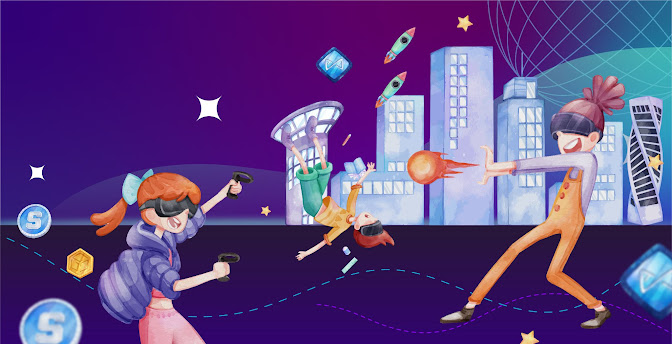Metaverse and Gaming: A Journey into the Virtual Frontier

Introduction
In recent years, the concept of the metaverse has captivated the imagination of both tech and gaming enthusiasts alike. The metaverse represents a virtual realm where individuals can interact, create, and engage in a multitude of activities in a seamless, interconnected digital universe. This revolutionary concept has significant implications for the gaming industry, promising to reshape how players experience games and fostering entirely new forms of gameplay and socialization. In this blog, we will delve into the fascinating world of the metaverse and its profound impact on the gaming landscape.
I. Understanding the Metaverse
The Emergence of the Metaverse
The term “metaverse” was first coined by science fiction writer Neal Stephenson in his 1992 novel “Snow Crash.” Over the years, it has evolved from a fictional concept to a tangible reality. The metaverse is essentially a collective virtual space that combines augmented reality (AR), virtual reality (VR), and other immersive technologies to create a shared digital environment. In this realm, users can interact with each other and digital objects, transcending the boundaries of traditional gaming experiences.
Key Elements of the Metaverse
The metaverse is characterized by its persistence, scalability, and interconnectedness. Unlike standalone video games, the metaverse is an ever-evolving world where actions have lasting consequences and where users can seamlessly transition between various virtual experiences. Moreover, the metaverse is not limited to a single platform or game; it encompasses a vast array of interconnected virtual spaces, making it a truly boundless and immersive experience.
II. The Impact of the Metaverse on Gaming
A Paradigm Shift in Gameplay
The metaverse presents an entirely new paradigm for gaming. Traditional gaming experiences are often confined within the boundaries of specific titles or game worlds. However, the metaverse offers a continuous and interconnected virtual space where players can move freely between different games, genres, and experiences. This level of freedom empowers players to craft their unique paths and narratives within the metaverse.
Player-Driven Economy and Ownership
In the metaverse, virtual assets take center stage. Players can acquire, trade, and even monetize their in-game items and creations, blurring the lines between gaming and entrepreneurship. Non-fungible tokens (NFTs) play a pivotal role in enabling true ownership of digital assets, empowering players with a sense of ownership and value for their virtual possessions.
Social Interaction and Collaboration
Gaming in the metaverse is not just about individual gameplay; it’s a social experience. Players can interact with one another in real-time, form communities, and collaborate on various in-game activities. The metaverse fosters a sense of camaraderie, enabling players to share their experiences, strategies, and achievements, leading to an enriched gaming environment.
III. Key Players and Innovations in the Metaverse
Decentralized Virtual Worlds
Several platforms have emerged as pioneers in creating decentralized virtual worlds within the metaverse. Platforms like Decentraland, Cryptovoxels, and Somnium Space offer users the ability to own virtual real estate and build, customize, and monetize their virtual creations.
Blockchain Technology and NFTs
Blockchain technology underpins the metaverse’s decentralized nature and security. NFTs, unique digital assets represented on the blockchain, have revolutionized ownership and trading in the virtual space, creating new opportunities for developers and players.
Integration of AR and VR
Augmented reality and virtual reality technologies play a vital role in shaping the immersive experiences within the metaverse. As these technologies advance, players can expect even more lifelike and interactive virtual environments.
IV. Challenges and Future Prospects
Technical Challenges
The realization of the metaverse comes with significant technical hurdles. Seamless integration across various platforms, ensuring data privacy, and maintaining server stability are just some of the complex issues that need to be addressed to provide a smooth user experience.
Regulatory and Ethical Considerations
As the metaverse becomes a more substantial part of our lives, issues of digital property rights, user safety, and ethical considerations will come to the forefront. Striking the right balance between freedom and responsible regulation will be crucial for the metaverse’s sustainable growth.
The Metaverse as a New Frontier
The metaverse has the potential to revolutionize not just gaming but also how we interact, work, and socialize in the digital space. It offers limitless possibilities for creative expression, collaboration, and immersive experiences, transforming how we perceive and engage with technology.
Conclusion
The metaverse is no longer a distant fantasy; it is rapidly becoming a tangible reality that promises to reshape the gaming industry and redefine how we interact with the digital world. With its persistence, interconnectedness, and player-driven economy, the metaverse opens up a universe of opportunities for game developers, players, and creators alike. As the technology continues to advance and players explore this new frontier, the metaverse is set to become an integral part of our digital lives, ushering in a new era of gaming and digital interaction.
Similar Articles
-

Mastering 2D and 3D Animation 03-04-2025
The Ultimate Career Boost in Today’s Creative Industry The demand fo
-

How to Make a Graphic Design Portfolio? 02-27-2025
Imagine walking into a room full of potential clients or employers, bu
-

What are the 12 Principles of Animation? 02-27-2025
Animation is more than just moving images—it’s the art of brea
-

The Changing Face of the Animation Industry 02-27-2025
The animation industry has undergone a seismic transformation over the
